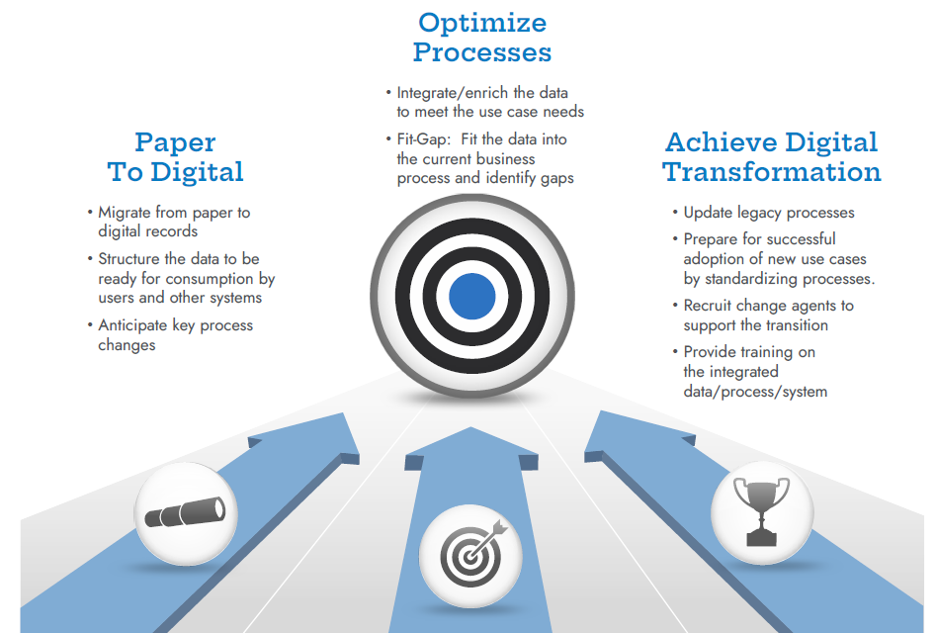The U.S. economy is integrating digital technologies at an accelerating pace. In a detailed analysis of changes to the digital component of 545 occupations covering 90% of the American workforce across all industries since 2001, a Brookings Institute report determined that the percentage of U.S. jobs requiring substantial digital knowledge rose from 5% in 2002 to 23% in 2016. During the same period, the share of jobs requiring low digital skills fell from 56 to 30%. According to a recent McKinsey & Company report, digitization is expected to contribute $2 trillion to the U.S. GDP by 2025.
In the life science industry, for example, technological innovation is quickly evolving the digital landscape. Advances in areas such as laboratory equipment, cloud-computing, sensor technologies, wireless networks, micro-electronics, and informatics software have helped to improve digitization and connectivity in the modern laboratory. Today’s scientific laboratories face an ever-increasing deluge of highly complex digital data that must be processed, stored, managed, analyzed and interpreted.
We live in a digital world of nearly instant communication and feedback, and organizations must be able to react quickly to changing conditions or risk going out of business. Since the year 2000, in fact, over half the companies in the Fortune 500 have either gone bankrupt, been acquired, or ceased to exist because of digital disruption. To remain competitive in today’s rapidly changing digital economy, companies must utilize digital technologies to innovate, evolve, and even revolutionize their business. As modern business leaders work to understand how best to leverage technology and become a digital enterprise, several terms have emerged to help guide and define the roadmap to success–digitization, digitalization, and digital transformation.
These terms are often used interchangeably, but in reality, they are quite different. Understanding the nuances of these differences is critical if your organization is going to survive and thrive in the 21st century business landscape. These days, managing change is not enough. Industry-leading organizations must establish themselves as change leaders by working to anticipate and stay ahead of disruptions. Developing a thoughtful and effective digital transformation strategy is an essential key for success in the face of present and future disruptions wrought by the digital revolution.
Unfortunately, many organizations make the mistake of equating digital transformation with digitization. This is a potentially devastating error, which can threaten the survivability of your business. In this blog, we will present a 3-step digital maturity model which defines these terms as different stages on the path towards digitally enabling and ultimately transforming your business. Understanding the path is an important prerequisite to successfully walking it.
Step 1: Digitization – Paper to Digital
Digitization is the foundational first step on the road to digital transformation. According to Gartner, “Digitization is the process of changing from analog to digital form.” In other words, digitization converts analog data into a digital format (e.g., converting paper-based documents into an electronic file) that can be understood by a computer system so it can be processed, stored, analyzed, and transmitted electronically. An example from manufacturing would be converting a manual or mechanical measurement into a digital one. For a hospital, it could mean storing patient records in computers as opposed to physical folders.
Digitization allows organizations to move from paper-based to digitally enabled work processes. By enabling a connection between the physical world and computer systems, digitization can provide significant business value to organizations–faster and more efficient communication, automation of manual tasks, reduced errors, lower costs, increased productivity, enhanced security, improved transparency, and efficiency.
Most businesses have already adopted digitization and seen some of these benefits as a result. Digitization is just the first step on the road to digital transformation, however. Simply moving from paper-based to digitally enabled work processes is not enough to remain competitive in today’s rapidly evolving economy. What if your work processes are inefficient? If the primary focus of your digital strategy is to speed up inefficient work process with digitization, then you just end up with faster inefficient work processes. The next step in the digital journey, digitalization, applies what one might call the radical art of business analysis to optimize your digitized workflows.
Step 2: Digitalization – Optimize Processes
Digitization is a prerequisite for the process of digitalization. The process of digitalization leverages digital technologies and digitized data to improve and automate business processes, and ideally the entire value chain of the business. As Gartner puts it, “Digitalization is the use of digital technologies to change a business model and provide new revenue and value-producing opportunities. It is the process of moving to a digital business.”
Utilizing emerging digital technologies such as informatics software, cloud computing, artificial intelligence, and the internet of things, the process of digitalization drives organizational change to improve competitiveness by unlocking value in digitized data. Industry leading enterprises are investing heavily in digitalization initiatives that create pathways to accelerated product development, improved quality and compliance, enhanced customer safety, and reduced cost.
While the technologies underlying digitalization continue to evolve rapidly, digitalization is not simply a matter of implementing more or better technology. Implementing technology to digitalize your business will not provide much value if the people who are supposed to utilize the technology do not adopt it. Effective organizational change management (OCM) is critical to harmonize the people and technical aspects of your digitalization initiatives.
Good business analysis is another important part of any digitalization project. Many IT projects fail to meet their full potential for delivering business value because of the misplaced emphasis on the technology itself, without addressing the organizational context and supporting business processes that are necessary to achieve the desired transformation. A good business analyst is invaluable for establishing appropriate system requirements and designing the optimized future state workflows that help to maximize the business value of the digitalization initiative.
In order to illustrate the concept of effective digitalization, consider a scenario where an organization wants to digitize all the data in a regulated (GxP) laboratory. One simple solution would be to scan all SOP documentation and move it to SharePoint. This would serve to digitize the environment, increase collaboration across functional areas, and make the data searchable. The problem with the solution, however, is that it would likely end up producing a non-compliant environment because of GxP documentation being housed in a non-validated system.
Instead of jumping into a quick and easy cloud-based solution like SharePoint, effective digitalization requires an approach that involves strategic planning. This project should begin with a thorough workflow and business analysis, which would include a risk assessment for GxP documentation. A comprehensive set of system requirements would come out of this process that would guide development of an appropriate solution. Depending on the organization and the tools available, they may or may not have a suitable solution that offers both flexibility of a SharePoint combined with the compliance of a tightly controlled GxP platform. If no system is readily available to satisfy the requirements, a technology selection process would commence.
A key point to consider here is that effective digitalization is inherently a cross-functional journey. In the above example (and really in all digitalization projects), the digitalization journey should not be left to the IT group alone to implement. Instead, business analysts should facilitate collaboration and gather key inputs from important stakeholders in quality and compliance in order to develop appropriate system requirements. In addition, effective change management should be employed to help mitigate and ease any stakeholder resistance to the chosen solution.
Digitalization helps organizations rethink legacy business models, consolidate applications, and unlock new opportunities for profitability and improved competitiveness. Yet a digitalization initiative should not be just about the technology itself. Good digitalization processes are strategic, engage key stakeholders from across the organization, and help create new value chains by facilitating work processes that are more efficient, flexible, sustainable, productive, and ultimately profitable.
Step 3: Achieve Digital Transformation
The overall effect of a series of digitalization initiatives across an organization is what is referred to as digital transformation. Digital transformation is essentially an end-to-end transformation of an organization which shifts operations from a legacy approach to new ways of working using both current and emerging digital technologies to deliver superior products, services, and customer engagement.
A digital transformation is more than just shifting operations, however. It will also involve rethinking and/or reimagining your company’s core value proposition, strategy, and vision as executives assess how digital technologies can enhance existing assets and capabilities to create new customer value. In short, digital transformation is the art of leveraging all the opportunities provided by digital technologies to future-proof your business so you don’t get disrupted.
A few high-level guidelines that will help your organization accomplish successful digital transformation include:
Develop a digital vision. The first step in digitally transforming your business is to develop a vision of what your organization can become by leveraging digital technologies. Items on the table for discussion will include optimized work processes, expanded capabilities, enhanced innovation, new revenue streams, and even new business models.
Develop a strategic roadmap. Once the vision is established, you will need a strategic roadmap that lays out the path to achieving it. While your roadmap should lay out proposed digitization and digitalization initiatives, along with proposed timeframes and sequencing, it will be a living document that will evolve and should thus be flexible.
Choose a good team. Creating and implementing your digital vision and roadmap is a big job that takes knowledge, creativity, and skill. There should be executive-level roles within your organization that are focused on developing, driving, and implementing your digital transformation strategy throughout the business. In addition, you’ll want your team to be cross-functional and include personnel from IT, Quality, and stakeholders from other key functional areas. Your IT team is critical to help keep and frame the discussion within the realm of what is possible.
Implementation of the roadmap will be a cross-functional journey. Don’t just hand off responsibility for implementing your roadmap to your IT unit. As discussed in the section on digitalization, collaboration between key stakeholders is best practice to ensure successful implementation of digitalization initiatives. In addition, given the rapid change driving today’s digital economy, customer preferences and needs often shift after the initial project “blueprint” is created. As a result, Agile development methodology is often the most appropriate approach due to its flexible and adaptable nature.
Choose the right partners. It is unlikely that you will have all the skills necessary for creation and implementation of your digital transformation strategic roadmap in-house. Skills like enterprise architecture, business architecture, organizational change management, and business analysis are critical to the success of your digital transformation. Seek out qualified, forward-thinking transformation partners with the necessary hard and soft skills you lack in house who have experience with facilitating successful digital transformations in your industry.
Don’t forget your people. It is important to understand that most digital transformation efforts fail. Why? Because many organizations fail to plan for the human factor. A survey conducted by the Society for Human Resource Management (SHRM) revealed that employee resistance (76%) to change is in fact one of the top reasons transformation efforts fail. If you want to create an organization that has breakthrough results, you need to guide your people to both embrace and lead the change. Effective organizational change management is essential to the success of your digital transformation efforts.
Conclusion
Given the rapid change driving today’s digital economy, your current business model is likely under threat. An agile, innovative competitor may very well be actively plotting a better use of data or a more clever use of technology to capture your market. It is crucial for CEOs to understand how current business models are being impacted by emerging digital technologies and make sure their organization is staying ahead of the competition by appropriately leveraging digitization, digitalization, and digital transformation.

To remain competitive, modern organizations must not only embrace change, but turn it into a core competency. For today’s change leaders, digital transformation becomes a way of life as opposed to simply a destination. In this dynamic environment, digitization is really just the first step. Industry-leading organizations are focused on digitizing information, digitalizing processes and roles that make up day-to-day operations, and digitally transforming their business and its core strategy.



